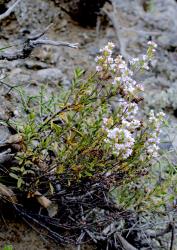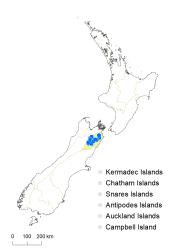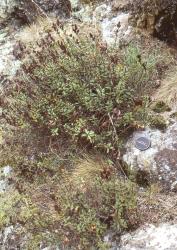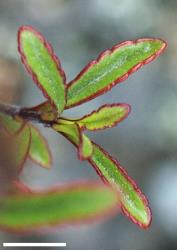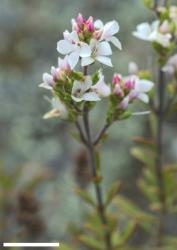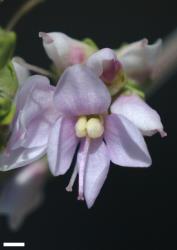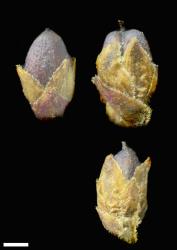- Taxon
- Gallery
- ≡ Hebe raoulii var. pentasepala L.B.Moore in Allan, Fl. New Zealand 1, 942 & 972 (1961)
- ≡ Heliohebe pentasepala (L.B.Moore) Garn.-Jones, New Zealand J. Bot. 31: 332-333 (1993)
- ≡ Parahebe raoulii subsp. pentasepala (L.B.Moore) Heads, Bot. J. Linn. Soc. 115: 82 (1994)
Perennial sub-shrub or low shrub to 0.45 m tall. Stems erect, or sometimes ascending, eglandular-pubescent; hairs uniform, short, reflexed to spreading. Leaf bud indistinct; leaves separating while very small, opposite-decussate, erecto-patent to spreading; lamina coriaceous, oblanceolate to narrowly elliptic, 7–30 mm long, 3–8 mm wide, glossy green to bronze-green above, dull green to pale green beneath; midrib evident; surfaces glabrous; margin glabrous, red, serrate or rarely entire, teeth in 0–7 pairs; apex sub-acute to acute or obtuse; base cuneate; petiole 2–8 mm long. Inflorescence a terminal compound raceme, 10–70 mm long; flowers crowded, 20–200, all bisexual; bracts opposite-decussate below, becoming alternate above, deltoid, > pedicels; pedicels erect-patent, 0–1 mm long, eglandular-hairy all around. Calyx lobes 5, sub-acute, 2.5–3.5 mm long, unequal, eglandular-ciliate. Corolla 6–8 mm diameter; tube pink with greenish base, 2.0–2.5 mm long, ≤ calyx, glabrous; lobes 4, white or pink, erect to spreading, sub-equal, elliptic to orbicular, 2.5–3.5 mm long, sub-acute to acute; nectar guides absent. Stamen filaments white, 2.0–2.5 mm long; anthers pale yellow. Style glabrous, 5–7 mm long. Capsules broadly angustiseptate to turgid, truncate to emarginate, glabrous, 3.5–4.0 mm long, 2.5 mm at widest point. Seeds fusiform to obovoid or irregular, weakly flattened, winged, smooth or weakly rugulose on back, pale to reddish-brown, 1.0–2.5 mm long.
Veronica pentasepala plants are similar to plants of another sun hebe, V. raoulii. However, V. pentasepala is characterised by a taller, more erect habit, often narrower and more widely spreading leaves, and five free calyx lobes, the posterior one usually only slightly smaller than the others. In V. raoulii plants there are four calyx lobes and the anterior pair are united for most of their length. Also, the nectarial disc of V. pentasepala is often glandular ciliate (hairs c. 0.1 mm), sometimes eglandular, whereas in V. raoulii it is usually eglandular and shortly ciliolate (hairs c. 0.02 mm), rarely glandular-ciliate.
South Island: Marlborough (Awatere, Clarence, Hodder, Leatham, Acheron valleys, Tarndale area).
Cliffs, rocks, rocky slopes, steep grassland, often on limestone. Recorded elevations range from 650 to 1740 m.
Flowers: September–November; fruits: December–February.
2n = 42 (Hair 1967, as Hebe raoulii var. pentasepala).
Veronica pentasepala is classified in V. subg. Pseudoveronica sect. Hebe and informally in the “sun hebe” group, formerly Heliohebe, Hebe “Paniculatae” (Albach & Meudt 2010), strongly supported by both molecular characters and morphology. ITS sequence data strongly suggest a relationship with V. raoulii, whereas cpDNA data suggest a relationship with V. scrupea (Albach & Meudt 2010).
Unidentified plants collected from the Omaka River and Black Birch Creek, Marlborough (e.g., CHR 470178), resemble V. pentasepala in their erect habit and narrow leaves, but are more like V. hulkeana in their pale lilac flowers and four free calyx lobes, and like V. scrupea in their four free calyx lobes and narrow leaves that are sometimes acute.
Cultivated plants occasionally have a few glandular hairs between the leaf bases at nodes, and their leaves sometimes have eglandular hairs along the midrib beneath.



